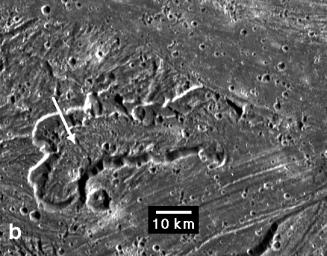Caldera in Sippar Sulcus, Ganymede
Caption:
An irregularly shaped caldera, or pit, within the bright swath called Sippar Sulcus on Jupiter's moon Ganymede dominates this image taken by NASA's Galileo spacecraft. The high-standing interior of the caldera is interpreted as evidence of the flow of a viscous material.
Elevation modeling indicates the height of the westernmost caldera floor material (arrow) is comparable to adjacent grooved material but decreases towards the east (right), where it is similar to nearby, lower-lying smooth terrain. The smooth terrain, generally lacking grooves or stripes, extends across the upper half of the image and crosscuts a similar but grooved band at the lower right. Analysis of such high-resolution images in combination with estimates of the features' relative elevations is helping scientists interpret the roles of volcanism and tectonics in creating the bright terrain on Ganymede.
This image was prepared by the Lunar and Planetary Institute, Houston, and included in a report by Dr. Paul Schenk
et al
. in the March 1, 2001, edition of the journal
Nature
.
Background Info:
The Jet Propulsion Laboratory, a division of the California Institute of Technology in Pasadena, manages the Galileo mission for NASA's Office of Space Science, Washington, D.C.
Images and data received from Galileo are posted on the Galileo mission home page at
http://www2.jpl.nasa.gov/galileo/
. Background information and educational context for the images can be found at
http://www2.jpl.nasa.gov/galileo/sepo/
.
Cataloging Keywords:
| Name |
Value |
Additional Values |
| Target |
Ganymede |
|
| System |
Jupiter |
|
| Target Type |
Satellite |
|
| Mission |
Galileo |
|
| Instrument Host |
Galileo Orbiter |
|
| Host Type |
Orbiter |
|
| Instrument |
Solid-State Imaging (SSI) |
|
| Detector |
|
|
| Extra Keywords |
Grayscale, Volcano |
| Acquisition Date |
|
| Release Date |
2001-03-13 |
| Date in Caption |
2001-03-01 |
|
| Image Credit |
NASA/JPL/LPI |
| Source |
photojournal.jpl.nasa.gov/catalog/PIA03217 |
| Identifier |
PIA03217 |

 Planetary Data System
Planetary Data System
